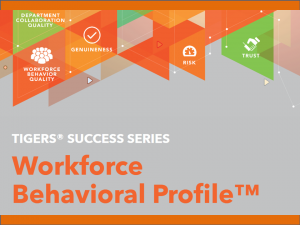 Workplace cultures are changing resulting in a need to focus more on employee strengths.
Workplace cultures are changing resulting in a need to focus more on employee strengths.
- Technology makes certain tasks quicker and easier.
- Employees’ roles are becoming more fluid than they have been in the past.
- Improved information and communication technologies allow team members to become more mobile.
- Employee job descriptions are more fluid, which allows team members to work on projects based on their individual employee strengths.
According to Gallup’s latest State of the Global Workplace report, employees who say that they use their strengths every day are 8 percent more productive and 15 percent less likely to quit. All of this points to how economical it is for leaders to shift their focus from stagnant roles toward a employee strengths approach.
The change in the workplace is in response to how employees work best. Many leaders are shifting to team-based arrangements. When done well, employee teams recruit members that fill out the employee strengths needed to get the job done with quality.
Frequently problem solving teams are assembled with one goal in mind. Once that goal is achieved, the employees are moved to a different team. This work design is more flexible for employees. New leaders also emerge. As a result these dynamic and fluid teams meet the needs of specific institutional customers or projects. The flip side to this increased flexibility is increased demands on employees. As a result employees need to be able to adapt to constantly changing roles. They also need to be more self-directed and better able to identify where their skills could be best utilized and which projects would allow them to excel. Quite frankly, this is a ground zero joy strategy for attracting and retaining talented Millennials.
Know your team members to determine employee strengths.
Employees who use their strengths in their positions are more likely to be intrinsically motivated by their work. This is because it feels less like work. Innate talent is a good place to start, Talent can be turned into employee strengths through practicing and honing skills. In order for this approach to work, leaders need to be intimately aware of their team members’ strengths, as well as their goals and desires for the future. When you know your team members on a personal level, you can then utilize assessments like Gallup’s Strengths Finder to identify their strengths in several different areas and then focus on training to improve their skills.
Another assessment that measures the quality of work culture and department behavior is based on six principles required for high performance. The six principles are trust, interdependence, genuineness, empathy, risk and success. The TIGERS Workforce Behavioral Profile offers three surveys in one to assess workgroup behavior, identify areas of strategic workforce development focus and then track return on investment for team interventions delivered. This assessment is then followed by optional annual micro training for all employees to develop those skills required for improving trust, for example. This unique system approach to building and honing employee strengths offers leaders the opportunity to facilitate employee conversations while improving strategic workforce behavior initiatives that gently transform workforce culture one week at a time rather than a one-off event with little to no retention.
interdependence, genuineness, empathy, risk and success. The TIGERS Workforce Behavioral Profile offers three surveys in one to assess workgroup behavior, identify areas of strategic workforce development focus and then track return on investment for team interventions delivered. This assessment is then followed by optional annual micro training for all employees to develop those skills required for improving trust, for example. This unique system approach to building and honing employee strengths offers leaders the opportunity to facilitate employee conversations while improving strategic workforce behavior initiatives that gently transform workforce culture one week at a time rather than a one-off event with little to no retention.
The six principles of trust, interdependence, genuineness, empathy, risk and success are research-based and validated, and they are anchored by positive behaviors that separate high performing groups from those that are not. These six principles enhance the success of your own organizational vision, mission, and values by strengthening cooperative team behavior that impacts group relationships, group roles and goals. It also shortens the time new teams spend in the stage of team growth called Storming. This is the stage filled with team conflict, misunderstandings, performance hesitation and false starts that cause so many new teams to falter. Fluid and temporary teams formed to solve problems, innovate a new product, improve an existing product or facilitate change require a system that allows them to hit the ground running rather than fumbling through confusion and conflict.
When behaviors that support these six principles are present, predictable high-performance team outcomes occur, and if any one of the principles is missing or less developed, predictable problems continue to arise. By analyzing your team’s collective opinion, you will become better equipped to laser-focus your time and resources on what will help your group to improve the most.
Complete Manager as Facilitator training to develop employee strengths
Leadership training should never be viewed as a one-and-done scenario. One-off solutions do not produce sustainable results.
Industry trends are constantly changing. Leaders should be open to adapt to ever-changing work environments, employee expectations and work demands. To accomplish this, leaders who view themselves as facilitators of high performance and complex problem solving and decision-making teams are capable of bringing people together to work toward solutions. As a result, groups accomplish more with high levels of commitment and accountability.
In Manager as Facilitator training, leaders are learn how to reduce group conflict, forge positive behavior and promote good decision-making on the part of all team members. Even if leaders have attended some training in the past, skill training is essential for building and leading successful, high-performing teams.
The workplace is constantly changing. Specific hard skills that were once viewed as imperative for success are now taking a back seat to talent and employee strengths.
Employees who use their strengths regularly in their positions are 8 percent more productive and 15 percent less likely to quit. This can be measured so it is not a pipe dream. As a result employers, are wise to give employees the opportunity to utilize their strengths. This leads to an evolution in the workplace where new leaders with specific strengths emerge. They lend success to forming, disbanding and reforming teams on an as-needed basis to accomplish strategic initiatives. The upward trend continues as employees are able to use their strengths for specific projects or clients. In order for this approach to work, leaders need to know their team members on an individual level, as well as facilitating problem-solving, planning and execution. When these elements are present,employee strengths shine as leaders lead their teams to success.
Care to dig deeper into this employee strengths conversation?
Here is a list of articles and resources for further insights into the topic:
- Strengths-Based Cultures Are Vital to the Future of Work
- State of the Global Workplace
- TIGERS Workforce Behavioral Profile
- Sample TIGERS Workforce Behavioral Profile Report
- Manager as Facilitator training
Copyright TIGERS Success Series, Inc. by Jennifer Zimmerman
About TIGERS Success Series Group Norm Facilitator Training
 TIGERS Success Series provides a Manager Facilitator training with a tool box that engages employees to identify the group norms that improve both department and company work culture. It helps organizations to re-engage employees, resolve conflict behavior and builds work relationships. These same resources and tool box can be used to onboard new employees and contractors onto existing teams so behavior is understood and normalized from the get-go. The training and tool box are brought to you when eight or more of your managers are enrolled.
TIGERS Success Series provides a Manager Facilitator training with a tool box that engages employees to identify the group norms that improve both department and company work culture. It helps organizations to re-engage employees, resolve conflict behavior and builds work relationships. These same resources and tool box can be used to onboard new employees and contractors onto existing teams so behavior is understood and normalized from the get-go. The training and tool box are brought to you when eight or more of your managers are enrolled.
Call 1-877-538-2822 US or 1-541-385-7465 international to inquire.